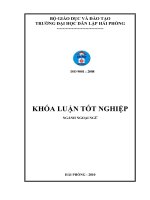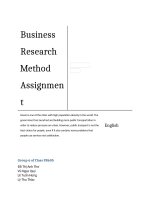research method english university
Bạn đang xem bản rút gọn của tài liệu. Xem và tải ngay bản đầy đủ của tài liệu tại đây (381.88 KB, 12 trang )
<span class='text_page_counter'>(1)</span><div class='page_container' data-page=1>
THE TRADITIONAL LONG HOUSE OF EDE ETHNIC MINORITY IN CENTRAL
HIGHLAND VIETNAM
</div>
<span class='text_page_counter'>(2)</span><div class='page_container' data-page=2>
Abstract
This study aims to describe the traditional long house of Ede people in The Highland
Central Vietnam in the past and in the modern life. The ethnographic study was done in
many villages of Ede people live in Dak Lak province As society developed, economic and
social as well as strong cultural exchange between communities should be the new generation
of Ede has changed the lifestyle trends and separated from the large family faded matriarchal
institutions. Therefore, the traditional long house interacts and changes and affects each
other in many ways through trade networks, telecommunications, educations, the
industrialization and the modernization of the country. The interaction and change can occur
from the global level to the local, a process called globalization. In addition, global trends
can be transformed within the local context to something new. The culture of
dominant groups often serves as the “index culture” for other groups.
Index cultures are found at all level: village elite, a city compared to a
rural area, and global capitals, which influence cultures in the periphery
(Miller, 2002).
</div>
<span class='text_page_counter'>(3)</span><div class='page_container' data-page=3>
Table of Contents
I. Introduction
II. Long house past
II.1. Materials
II.2. Architecture
II.3. Number of people and things in the long house
III. Long house present
III.1. Materials
III.2. Architecture
</div>
<span class='text_page_counter'>(4)</span><div class='page_container' data-page=4>
Introduction
In the picture of Vietnam’s culture has polychromatic color. The Central Highlands
emerged as a cultural which many nuance’s convergence of many residents in the area (45
ethnics - including 13 indigenous ethnics), with diversified architecture of the communal
house, wooden sculpture the grave, Gong culture, the folk songs, dancing people. And the
folk festivals are celebrated buffalo stabbing festival used to sacrifice animals, reflecting the
polytheistic beliefs of ethic minorities live here. In which Ede ethnic - an indigenous ethnic
group in the Central Highlands, with its long history is measured in millennia and their
unique features, the definition has a very unique city, a strange attraction for fascination with
those share cultural capital, while in the other one can recognize the relationship back and
forth between a close race with their neighbors in the Central Highland in particular -
Southeast Asia in general.
When we are concerning about the traditional culture of the Ede, we have to mention the
long house contained many elements of traditional culture of the Ede. For a long time, the
traditional long houses of Ede went to on legend, epic, rhyme words of the people. This is
also the place where the cultural activities, beliefs and practices of the Ede, such as reviews
of the Gong festival, Tet festival. Beside, that is the place where community events such as
Khan story, lullaby, Aray ( folk songs), reception, treatment customary laws, drinking Can
wine, holding ceremonies of the family, the human life cycle, within the rice community
according to the customs of the Highlands.
</div>
<span class='text_page_counter'>(5)</span><div class='page_container' data-page=5>
Long House past
Materials
Ede people’s long house is a special cultural indicator of the community’s matriarchal
system. The long house is a house on stilts and a symbol of the Ede matriarchal. It was built
in harmony with natural conditions of the Central Highlands and in accordance with
community of customs, religion, and sentiment. A typical house of Ede people is the
longhouse made of bamboos and woods, roof and floor bone, bamboo floor, bamboo walls
surrounding the home, or bamboo roof thatched with grass, leaves or plaited rattan back.
Popular size is the long bar from 3.2 to 3.4 m long, 3.6 to 4 m high column, the large heart
from 4.5 to 5.3 m and a long house usually 100 m long.
This is a traditional long
house of Ede people.
Architecture
The longhouse's space often divides into two parts. A part of long house known as “Dring
<i>gah”( in Ede language) the front yard is a part's area makes up 1/3- 2/3 the total area is </i>
considered as the living room and “Dring Gah” is the place to guests, the activities of the
whole length, the kitchen, guest chairs, the chairs, benches (long about 30m – 50m),. The
other half “Dring Ok” (behind yard) is a common kitchen and cook is the domicile of the
married couple, split vertically, the left part is considered "on" time divided into many small,
part of the right is corridor for goods movement, on the other end is where the kitchen and
</div>
<span class='text_page_counter'>(6)</span><div class='page_container' data-page=6>
also are bedrooms by Ngô Tiến Sỹ (2009), Retrieved October 8, 2010 from
/>
There are two doors: the front door is for men, the back door is for women and two stairs:
male stair and female stair.
The house build in the villages stretch along the North-South direction, doors, up and
down stairs normally open two gables. The long house builds like that because of avoiding
the dry northeast wind, southwest wind during the rainy season. The roof cut long way to
avoid the sun's highest sunshine hours in the day projection.
The front yard often arranged two stairs to the house, one for guests (stairs one) and one
for members of the family. Stairs lead directly into the most important shortstop customers.
It is ground floor after cooking, there is a staircase down for family members, and visitor
must not leave this path.
</div>
<span class='text_page_counter'>(7)</span><div class='page_container' data-page=7>
Number of people and traditional things in the long house
In Vietnam, most ethnic minority groups are belong patriarchy, but
especially the Ede until now are matriarchal, because women control and
manage everything in their families (they are the leader of their family),
meaning that women have more power than men. Some people do not
agree with this norm. In addition, in Ede culture, normally, the families of
Ede girls make proposals of marriage to men, and once wed the couple
resides with the wife's family and children bear the mother's family name
(Thach, 2006). Inheritance is also reserved solely for women, in particular
the youngest daughter of the family. This can make some adolescents
become homeless when their mother or father who dies or divorces,
because the matriarchal system of the Ede does not allow children to live
with their father after their mothers death, so children can go to live with
their kinship or other family. Each house usually floor length from seven to nine
nuclear families living in.
In addition, in the long house have many traditional thing such as Gong, (Kpie Ceh) Jars
of wine, Bro musical instrument, Ding Nam musical instrument, prestige goods, or a long
chair, known as “Kpưr Gah”, made from an ancient tree …
The stairs with images of stars, crescent moon, and breasts
</div>
<span class='text_page_counter'>(8)</span><div class='page_container' data-page=8>
Long house present
Materials
According to Vietnam News Agency, from the 1980s to until now, Dak Lak province
made the separation of household, develop economic zone, creating conditions for ethnic
minority develop economic – social and improve of their life. That is the time the long house
is at risk of long deletes. After separating, each household was to support a part of expense
and facilitate to buy the materials to make their long house; most people build the house as
the Kinh such as villas, bungalows. Retrieved from
People in many villages, after the life was improved better and renovated, people did not
care of the traditional long house, they became build high-rise, villas. Not just the village of
Buon Ma Thuot in the right of the people in villages in remote districts like Cu M'Gar, Krong
Buk, Krong Ana , Cu Kuin...the traditional long houses also be removed, replaced it with
high-rise buildings. Culture and the length of Ede ethnic are losing in the development of
society. (Binh, 2004)
Nowadays, a typical house of Ede people is the longhouse made of materials: brick, sand,
iron, and cement. These materials are easy to find out. These are not made of natural
materials. So the long house is lost beauty of nature. A house now far longer than traditional
houses does. Previously, the regular return of the village main road, but by winter, the many
should be built according to the box, type the chessboard. The traditional long house
increasingly shorter, if the past is hundreds of meters long, but now, the only 20-30m long,
many only 12 meters long, limited by land, while households with less People should not
Kpie ceh (Jars of wine)
Bro (musical instrument of
Ede people
</div>
<span class='text_page_counter'>(9)</span><div class='page_container' data-page=9>
build a house usually too long. The materials have changed, if the long columns previously
made of wood, now replaced with concrete in many houses. Floors usually made of timber,
bamboo, now made of sawn planks. The roof was thatched with iron, by tile. This was due
to the rapid exhaustion of the natural resource.
We can see the image 2.1 Ede long
house nowadays and it is not popular in
many villages of Ede people. It is now
become communal house to people
meeting, celebrate some festivals in the
year. And each village often has one communal house.
Architecture
Nowadays, the long house’s space is divided into three parts: with a yard, a guest area, and
a residential room for its members. One house has two ground floors in the first two houses.
Stadium floor at the main entrance (front yard) often call guest room. This is often the seat
play, red cooler, an area widely. Front yard often arranged two stairs to the house, one for
guests (stairs one) and one for members in their home. Stairs lead directly into the most
important shortstop customers. It is ground floor after cooking, there is a staircase down for
family members, and visitor must leave this path. Sometime the long house has one stair in
the front of yard and one in behind yard. But the stair in front of yard often makes big stair
and wide, so people can up and down comfortable
On the other hand, the orientation of building is up to a host, one’s house was built follow
the direction of the road, people build a house modern architecture and economical condition.
Moreover, the stair with no images of animals such as turtles, lizards and crescent moon,
breasts. They do not care the value of the traditional long house
</div>
<span class='text_page_counter'>(10)</span><div class='page_container' data-page=10>
We can see the picture 2.2, the stair make simple and has three steps with no images as the
past.
Image 2.2
Number of people and things in the long house
Vietnam today stands at a crossroads. It has been at peace for over a
decade, but since the 1986 introduction of the "Renovation" or “Đổi Mới”
policy that began dismantling the country's socialist economy in favor of a
market economy, the country has experienced tremendous social
changes. Many small commercials and agencies from the lowland move
to highland. Therefore, the long house of the Ede minority now has also
changed including developing of the economy in their homeland. For
example, because of limiting the size of the house, in the house often has from two to three
nuclear families living in and the owners still are women, holding their whole life in the
family. Children bring their mother, son not inherit, men residing in the wife. The family
was separated into many small households and a little generation living.
Binh (2006) claimed that “different from the past, the traditional long houses of Ede
people have many changes now”. That is the texture, pattern as other decorative home long
ago. Rafter's houses on Long columns are no longer carved pictures of animals familiar with
the Highlands as elephants, turtles, varan.... Things as Gongs, Drums, copper pot, child seats,
seat owners ..., alternatively by modern furniture such as TV, DVD player, salon chair, fridge
... even in the Central Highlands, there are very few people understand the meaning of the
decorations, supplies them.
</div>
<span class='text_page_counter'>(11)</span><div class='page_container' data-page=11>
In general, the traditional long house of Ede people has many changes: materials, the
architecture, the direction…especially is number. In the near future if the Ede cannot
preserve, the traditional long house will be losing.
According to Bui Ngoc Quang M.A, officials Ethnology Museum of Vietnam, who has
spent years studying the traditional long house in Highland, said the Central Highlands
provinces have started the interest in conservation of traditional ethnic. In addition to
building a long house in the museum, the local trends are preserved traditional homes by
giving village a destination of the tour. Besides, the construction of model villages as
cultural tourism (as the same model village in the north) may also be applied to preserve the
length of the Highlands in the current period. However, factors limiting the
commercialization of implementing these measures.
Conservation activities, the museum contributes in keeping the term, maintaining
traditional cultural values of the ethnic minorities. However, for the long-preserved, the
people of the village played an important role, because they are the direct construction, use,
condition the decision of the house. Therefore, the need to promote advocacy for people, so
they see the value of the long and consciously preserved the original term, or at least brought
a certain element of tradition in the construction, as decorative items and order in the house,
or use some new material but still not lose the identity of the long-Ede.
</div>
<span class='text_page_counter'>(12)</span><div class='page_container' data-page=12>
References:
Trần Văn Bính (2006), Đời sống văn hóa các dân tộc thiểu số trong quá trình hiện đại hóa, Lý
luận chính trị Quốc gia
Trần Văn Bính (2004), Văn hóa các dân tộc Tây Nguyên: thực trạng và nhũng vấn đề đặt ra,
Chính trị Quốc Gia
Ngô Văn Danh (1999), Nhà dài Êđê, trong bảo tồn và phát huy bản sắc dân tộc, T.p Hồ Chí
Minh, p. 404 - 419
Bế Viết Đằng (1982), Đại cương về dân tộc Êđê Mnông ở Daklak, Khoa Học Xã Hội.
Nhà dài – nét văn hóa đặc trưng của Ê đê, Retrieved September 23, 2010, from
/>Cần bảo tồn kiến trúc nhà dài đồng bào dân tôc Êđê, Retrieved October 2, 2010 from
/>
</div>
<!--links-->
<a href=' /><a href=' /> Development of a method to measure consumer emotions associated with foods
- 10
- 784
- 3








